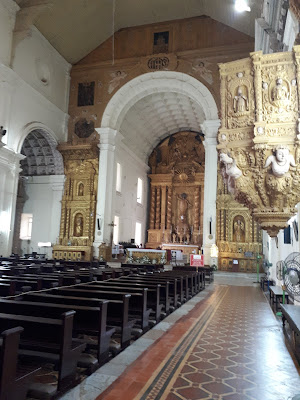 |
| Basilica of Bom Jesus, old Goa Velha India en.wikipedia.org |
 |
| Basilica of Bom Jesus, old Goa Velha India en.wikipedia.org |
Basilica Bom Jesus of old Goa (Goa Velha) even today stands as a fine example of Baroque architecture (highly decorative and theatrical style, quite popular in the 17th century) with imprint of colonial Portuguese. The Jesuit church, consecrated way back in 1605 CE, is home to the mortal remains/ sacred relics of St. Francis Xavier. An artifact of history, it is a UNESCO recognized world heritage site.
Historian Paulo Varela Gomes (2011: 68) states:
“The Bom Jesus has a unique façade in the history of Christian architecture, one of the outstanding monuments of the architecture in India.” Further, he adds that the lasting contribution of the basilica is that it “allowed Indian artisans to domesticate European architectural and ornamental vocabulary, to make it their own” (2011: 70).
'Not only the artisans and labour involved in its construction were local, but much of the material with which the church was built, such as the laterite stones and timber, were also sourced locally.'
 |
| Basilica Bom Jesus, Goa. themiskitrail.wordpress.com |
Above image; Basilica Bom Jesus, Goa; Damaged laterite stones on the exterior wall.
 |
| Basilica Bom Jesus, Goa.themiskitrail.wordpress.com |
Above Image: Basilica Bom Jesus, Old Goa. Details on the Basaltic columns.
This heritage church is in a place which was once the capital of Goa commonly called Old Goa and is about 10 km from the new city of Panjim, Goa. The Basilica of Bom Jesus or Basilica of Good Jesus (Portuguese: Basílica do Bom Jesus), considering its antiquity and time factor, is gradually wilting due to aging. Lots of visitors come here because it is one of the well- built churches in this part of Goa. What has saddened me is this fine iconic church is not only losing its old charm and aura, but has also become structurally weak. In course of time it may shed its old and fascinating look, as the exterior red color is rapidly getting faded and now it has become dull. The structure that has stood the test of time for 400 years, has a gaping hole in its roof and it means it may be susceptible to flooding during the monsoon rains.
 |
| .location map Goa, India. goaidc.com |
What are the reasons for this slow deterioration of this church? Though there may be many, there are four primary reasons:
01. The exterior walls of the church have been neglected and not maintained periodically for a long period, though the interior is fairly kept well.
02. Lack of adequate funds and apathy on the part of the ASI. The church management has failed to pressurize the Archaeology Sur. of India.
03. Exterior wall degradation is caused by the construction materials. The walls are constructed with laterite stones and columns with basaltic rock stones. Rich in iron and aluminum and normally laterite is found in hot and wet tropical places and is prone to weathering over a long period of time. The rich rusty-red coloration is due to high iron oxide content. Formed due to leaching of parents rocks by percolating water, it hardens upon exposure to moisture.
04. As far as this church is concerned it is due to continuous exposure to climatic vagaries, proximity to the sea near-by and unseasonal rain all through the year. These have caused further deterioration of the red church.
 |
| Basilica of Bom Jesus, old Goa Velha India en.wikipedia.org |
Above image: View from the road side, near the entry gate of the Basilica Bom Jesus (consecrated in 1695) in old Goa (Goa Velha), India. The original red color on the exterior wall is well faded due to climatic changes coupled with poor upkeep........
Consequently, the walls of the Basilica remain wet promoting saturation on the laterite walls. At one stage water even starts dripping through the inside walls. It is said it never happened in the past prior to the 1950s.
 |
| Basilica Bom Jesus, Goa 1950s epw.in/engage/article |
The above image: The originally lime-plastered and whitewashed Basilica of Bom Jesus in 1890, photo taken by Souza and Paul. The current brown look of the Basilica is the result of restoration carried out by Baltazar Castro in the 1950s. Source: Central Library of Goa, Panjim
Scholars and historian say that this Basilica's exterior was fully plastered like every other church in Goa and remained so till decades ago since its inauguration in 1605. In the early 1950s, it bore a white look imparted by its limestone plaster.
 |
| Basilica of Bom Jesus, old Goa Velha India en.wikipedia.org |
The trouble began in the early 1950s (Goa was part of Portugal then) when ‘conservation’ architects from Portugal had it removed during the reign of the Portuguese Prime Minister Antonio Salazar. Reason: Economic and cultural renewal of Portugal and its overseas territories and renovation of Old Goa for the exposition of St Francis Xavier in 1952. The grave mistake they made was the Portuguese did conservation without consultation with local experts in Goa. The ''Basilica has been dying a slow death ever since.''.....''If we want to conserve the Basilica, we have to re-plaster the exterior to avoid a major tragedy in the future,” according to Fr. Fernandes.
To prevent further damages and deterioration of the walls, the Church authorities have got in touch with experts from the Archaeological Society of India (ASI) as well as conservation trusts. Will the ASI respond quickly to save this Portuguese colonial structure that is older than the Taj (1632-1648)?
https://www.epw.in/engage/article/restoring-basilica-bom-jesus-and-archaeological-survey-india
https://www.heraldgoa.in/Review/Preserving-a-World-Heritage-Monument/160394









